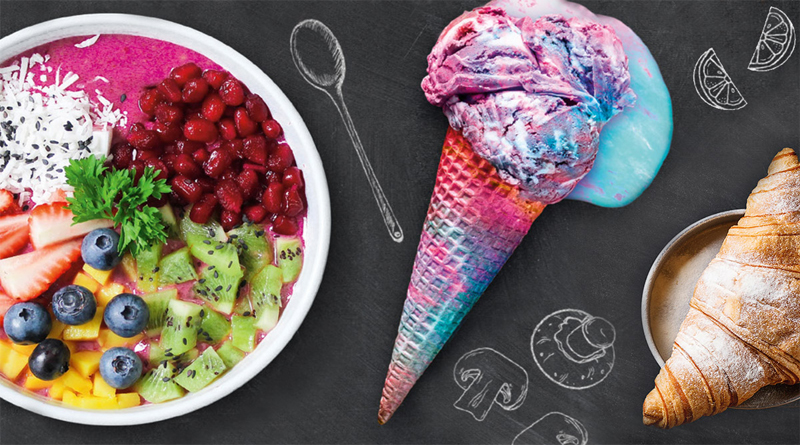Naturalness in flavors is expected to lead the way in 2019, although classic flavors are still anticipated to be in high demand across all categories. New combinations including botanical, ethnic and exotic flavors currently have the potential to meet consumers’ increasing demand for exciting new creations. These trends are tipped to become increasingly popular for the coming year. FoodIngredientsFirst spoke with key suppliers in the flavors space, who offered their insights into what we can expect to see trending in 2019.
Botanical flavors will be a major trend for beverages, sugar confectionery and dairy in 2019, according to Florian Buttmann, Product Management Ingredients WFSI – ADM Nutrition. “Our portfolio incorporates popular flavors while also generating a buzz with unexpected flavor accents; fruits with a hint of spice or aromatics from natural extracts of popular herbs and flowers. Hibiscus, for example, goes well with apple, basil with red berries,” he tells FoodIngredientsFirst.
Florian Buttmann, WFSI
Confectionery products certainly have extremely high development potential, in terms of both texture and taste, according to Buttman. “Due to consumers’ increasing health consciousness and global regulation issues, sugar-reduced products are becoming more and more relevant. Nevertheless, consumers do not want to compromise on taste. The challenge is to enable manufacturers to reduce sugar while offering a full taste experience,” he explains.
“Consumers are eager to try new flavors and expect new impulses accordingly,” he continues, “And we are noticing a change in the perception of taste. The move away from sweetness and toward what are considered to be adult flavors is certainly a trend that will continue,” Buttmann claims.
He also maintains that today’s consumers are increasingly curious about new taste experiences. “Due to global travel and the intense use of social media consumers are often already familiar with a wide range of different flavors. In the quest for new experiences, consumers are increasingly keen to experiment. They are open to particularly unusual flavors; a classic example of this is tonic water with pink pepper,” he says.
For Carolyn Chen, Marketing Manager, Flavor at Takasago, US consumers, particularly the younger generations, are exposing themselves to authentic ethnic cuisines as there is a growing interest in new and exotic eating experiences and flavors. “Global cuisines introduce consumers to regional spices, herbs, fruits, or vegetables. Global cuisines range from savory dishes, exotic beverages, decadent desserts, and more. Flavor inspirations are predicted to be drawn from authentic Japanese, Korean, Filipino, African and Middle Eastern cuisines,” she notes. “Another trend is street flavors – street food and food truck inspired. More and more retail products and restaurants are highlighting ethnic flavors or street flavors. This will appeal to the ever-growing adventurous consumers. As a global company, Takasago is well versed in an array of ethnic flavors that work in all application types,” Chen adds.
Floral and botanical focus
Hugh Evans, Synergy Flavours Marketing Manager for Europe and Asia, agrees with the notion that botanical flavors will be in the spotlight next year. “The use of floral and botanical flavors enables manufacturers to create new dimensions and add more complex tastes to existing products. Innovative taste profiles can be developed by pairing niche botanical profiles with more familiar fruits and vegetables. Our flavor and application teams at Synergy have developed combinations of botanicals and fruits, including a strawberry and geranium yogurt and a cherry blossom muffin,” he explains.
Synergy has recently undertaken some extensive research on emerging and popular flavors in the sports nutrition markets in Latin America and North America, according to Evans. Unusual and innovative flavors are expected to trend across food categories in 2019 including Japanese flavors such as Yuzu (a citrus fruit) and Mochi (a sweet rice-based dessert).
“Due to the global appeal and highly competitive nature of the nutrition market, we expect to see these flavors, however, with other categories looking further afield for inspiration, we believe these flavors may also translate into bakery, dairy and beverages.”
“With a focus on sugar reduction in food, we see more experiments with savory flavors and ingredients, blurring the lines between sweet and savory. This is an emerging trend particularly in healthier snacks, which are often high in fruit, contributing to total sugar levels,” Evans notes.
“We also tend to see an increase in flavors where the ingredient has associated health benefits,” he comments. “For instance, blueberry remains a popular flavor choice for healthier products because consumers associate the flavor with the purported antioxidant properties of the fruit. And last year, we saw enormous interest in turmeric for similar reasons.”
“With consumers becoming increasingly more concerned with sleep and mental health, this year, we may see something like Montmorency sour cherry (a supposed sleeping aid) start to trend, and in turn grow more actively as a flavor profile. Interestingly, Montmorency was a profile we highlighted as ‘growing’ in North America as part of our Flavors of the Future research,” he explains.
The sports nutrition market, for Synergy, is also an area to watch. This market is one of the most dynamic in terms of flavor development, according to Evans. “We have done a significant amount of research into the Latin American and US markets and looked at the flavors that are likely to emerge over the next few years. We found that flavors such as Cookie Dough, Birthday Cake and S’mores are trendy in North America and Tres Leches, Creme de Papaya and Alfajores (cookies sandwiched together with a caramel-like sauce) from Latin America, are all flavors which are well established, but we predict will make an appearance in the sports nutrition market in Europe in the next year,” Evans claims.
Latin America produces some incredibly diverse flavors that are both versatile and interesting, he says. “This part of the world also offers flavors such as pitaya (or dragonfruit) and açai. These fruits and berries deliver flavors that work particularly well in drinks because of their fresh, sweet notes, but they are also being used in other applications, including snack bars and convenience foods.”
Evans also notes a steady move towards more savory tastes in a wide variety of different applications. “From the likes of herbs being used in ice creams and cocktails, to the appearance of bacon in sweet desserts, there seems to be a sense of ‘anything goes’ as far as today’s consumer is concerned,” he comments. “We believe that this is a change that will continue well into the next decade as consumer taste for innovative flavors and flavor combinations evolves further and traditional boundaries are broken.”
Smokeless smoke?
According to Megan Byrnes, Marketing Representative at Gold Coast Ingredients, the company is gearing up to see smokeless smoke type flavor trends next year. “What do we mean by smokeless smoke type flavors? Smoke type flavors that replicate the taste of wood-fired products, but without the fire,” Byrnes states.
A growing number of smoke-type flavors are being developed without the use of any by-products of combustion. As a result, these flavors are environmentally-friendly and accepted in the EU. Popular flavors to watch out for in 2019 are hickory smoke type, BBQ smoke type, applewood smoke type, mesquite smoke type, cherry wood smoke type and so on, according to Byrnes. “Smoke type flavors are already found in a variety of products including snack foods, meats and meat substitutes, seasonings, sauces, cheeses, honey, and salt. In addition, we foresee smoke type flavors used in trending dessert and beverage products,” she adds.
Meanwhile, food and beverage manufacturers are exploring flavor innovation with kiwi fruit, and Byrnes predict kiwi flavor combinations will make a strong appearance through 2019. “We have seen
Kiwi flavor combinations are expected to make a strong appearance through 2019.
an increase in demand for kiwi flavors mixed with other fruit flavors in the beverage and dairy industries. In addition to the infamous strawberry kiwi duo, we anticipate in 2019 the market will see more kiwi fruit pairings such as kiwi pear, kiwi watermelon, kiwi lime, kiwi cucumber, berry kiwi, and kiwi melon,” she claims.
The market today provides a nearly unlimited selection of flavors, causing consumer taste to be more precise. With more options at their fingertips, consumers really know what they are looking for and they have the purchasing power to demand specific tastes, Byrnes explains. “For example, whether consumers prefer true flavor profiles or candied flavor profiles, flavor manufacturers are challenged to deliver the perfect flavor profile. Consumers are noticing differences between a ripe banana flavor versus a candy banana flavor or an unripe blueberry flavor versus a ripe blueberry flavor. As a result, flavor manufacturers must understand and deliver exactly what type of profile the consumer is expecting to taste,” she concludes.
What’s next?
As consumers become more and more open to trying new flavors from around the globe, flavor creation, innovation and combinations are set to become much more exciting. Traditional flavors will continue to have a place in NPD, especially in specific categories, such as ice cream and savory snacks, but there will be more scope for flavor development now that “adventurous” consumers are eager to seek out new experiences in 2019
Source: Food Ingredients First








